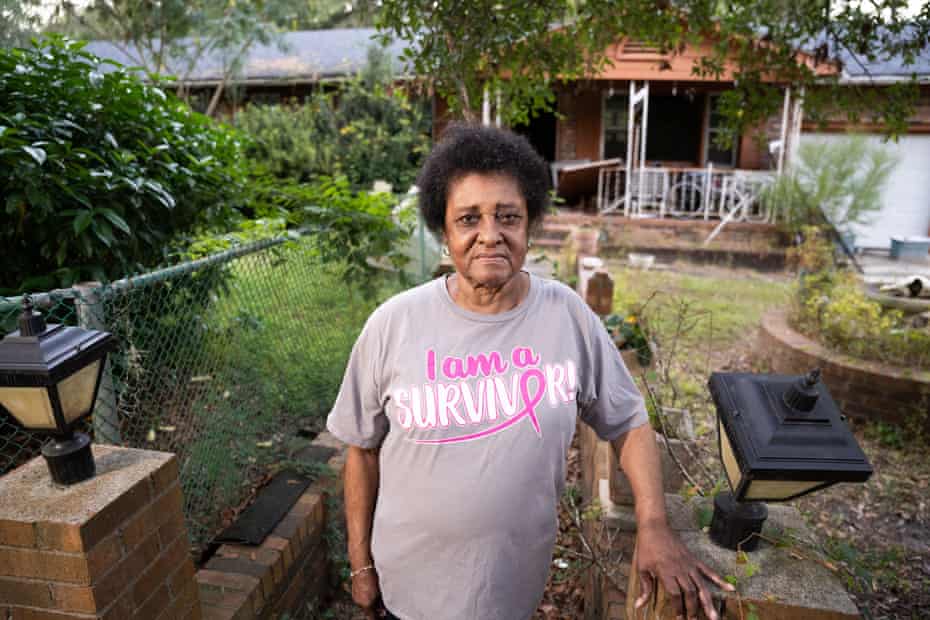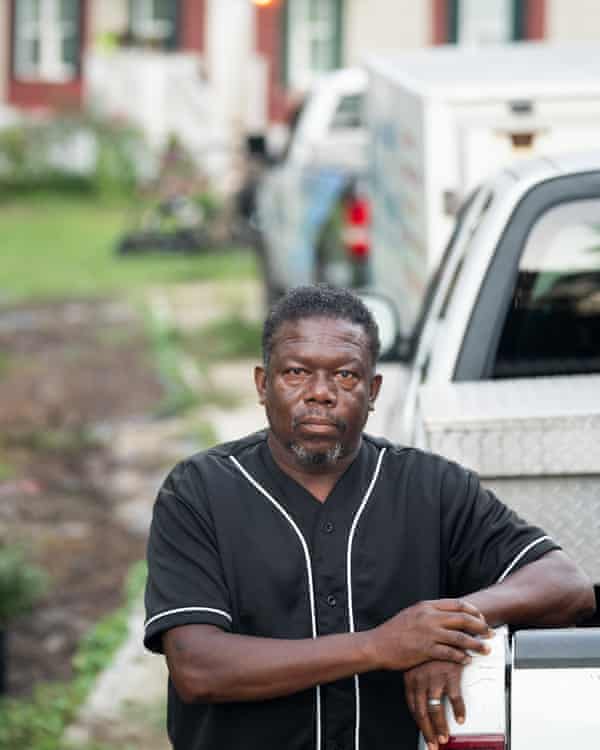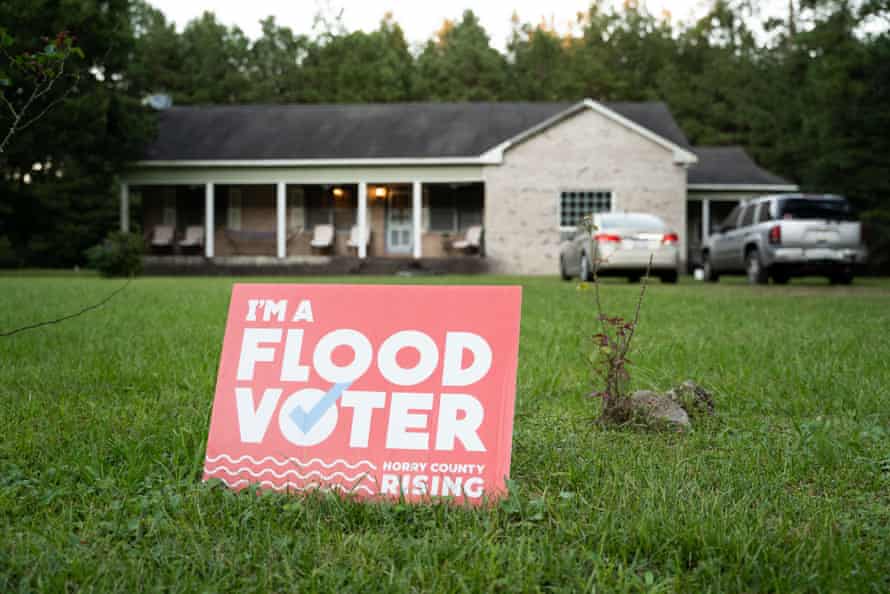‘The leading cause of Black land loss’: how the climate crisis is supercharging dispossession

When informal heirs’ property owners cannot access disaster aid the racial wealth gap grows larger
Margaret Alston doesn’t remember the night that Hurricane Matthew hit, but she remembers how afraid she was of the flooding that followed.
The biggest hurricane to hit South Carolina since 1999, the storm caused massive inland flooding across large swaths of the south-east. In Bucksport, the small, unincorporated town where Alston grew up, the Wacamaw River overflowed, inundating the street Alston’s house is on and making it impassable.
“The water was everywhere,” she says. “And when I say everywhere, I mean everywhere.” She found refuge at a nearby community center, before moving in temporarily with her sister in Conway, 14 miles away.
Six years later, she is still in Conway, her house sits abandoned and in disrepair, and the funding allocated to Hurricane Matthew victims has dried up. Alston did apply for and receive some assistance from Fema after the storm, but it was a fraction of what she needed to repair her house – and mold had set in quickly after the flood.
“I would be so glad to be back,” Alston says. But she sees little hope in that happening.

A contractor estimated the total cost to repair and elevate Alston’s home. But in the process of applying for Fema funding, private loans and nonprofit help, Alston discovered that, in many cases, she was eligible for assistance only if the deed to the home and land was in her name. As it turns out, Alston was not eligible, because legally she is not considered the owner of her home.
Alston’s house – and the land it sits on – are what’s known as heirs’ property, meaning they were passed down informally, generation to generation. Alston shares a partial interest in the house with all living descendants of the original deed holder: her grandmother. With each generation, that interest is split again among the newest descendants – but none of them hold the actual title.
That means that, because she doesn’t legally own the home, she can’t use it as capital for loans and mortgages as other homeowners might. She is also excluded from many federal and state grants historically given to homeowners to recover from disasters. She is now at risk of losing her home entirely. The US Department of Agriculture calls this unstable form of property “the leading cause of black involuntary land loss”, and increasingly, scholars recognize it as a contributor to the growing racial wealth inequality in the US.
Heirs’ properties are disproportionately found in the Black Belt – a tract of more than 600 largely rural, underserved counties with higher-than-average African American populations and high poverty rates. But heirs’ property can occur anywhere where property is passed on without a will.
For many, like Alston, living on heirs’ property usually doesn’t become an issue until disaster strikes.
“It’s not a problem until it’s a problem,” Laura Tuggle, executive director at South Louisiana Legal Services says. And by then, the problem can become very large – the difference between saving your home or having to abandon it altogether.
A barrier to federal assistance
Federal disaster assistance and other grants almost always require clear proof of title.
After Hurricanes Katrina and Rita hit New Orleans in 2005, 25,000 heirs’ property owners were denied Fema assistance. Tuggle’s organization assisted thousands of families who were trying to clear the property titles of their homes in order to access recovery dollars.
“This is a critical issue for low-income people, especially when you live in coastal areas,” says Tuggle.

Major hurricane and flooding events – from Hurricane Harvey to Maria to Sandy – have revealed the scope of the problem.
Roughly 50,000 heirs’ property owners in Puerto Rico were denied Fema assistance after Maria because they couldn’t show proof of ownership, and thousands more surfaced after Harvey in Houston. When Hurricane Matthew hit South Carolina in 2016, more than 18,000 disaster assistance claims were denied. Half of those applications came from the counties with the highest prevalence of heirs’ property in the state.
Despite the scope of the issue, data on heirs’ property is fractured and incomplete at best. What data does exist suggests that this form of land ownership disproportionately affects Black southerners, with some estimates suggesting that heirs’ property makes up as much as a third of all Black-owned land in the south, and others suggesting it could be as high as 60%.
The legacy of explicitly racist housing policies and lack of access to legal services has meant that for many Black families, land passed down informally was often thought of as a secure way to manage property. But heirs’ property doesn’t just affect rural Black Americans. It is found all over the US, particularly in areas historically excluded from the legal system. Outside the Black Belt, heirs’ property is frequently clustered in settlements along the US-Mexico border, tribal lands, and in Appalachia – but also in cities like New York.
Wherever they are, heirs’ property owners lose out on more than just Fema assistance. Rob Young, who serves on South Carolina’s Flood Water Commission, says the question of homeownership is a “non-starter” for residents trying to access aid from government agencies like Fema, the Small Business Administration, Hud, and even USDA, in cases where families farm on the land.
“The inability of individuals to show clear title,” he says, becomes a roadblock to accessing federal funds for “whatever it is that they want to fix”.
When homeownership is a standard by which the state determines who does and doesn’t receive aid, the system for cleaning up and preparing for disasters ends up reinforcing inequality.
Few climate adaptation plans acknowledge the particular challenges that heirs’ property presents. Other non-homeowner groups like low-income renters, who are disproportionately Black, Hispanic and Native American, are similarly excluded from aid and assistance. Experts say lack of attention to this kind of racial inequality when planning for climate change will increase wealth inequality and further the unequal distribution of climate impacts.
As of August, Fema has announced changes to the way they verify homeownership for disaster relief applicants unable to show clear titles, such as heirs’ property owners.
But disaster relief is only the tip of the iceberg.
Experts say heirs’ property owners may struggle to unlock the funds that could help them prepare for the next natural disaster, from state and federal grants to private loans and mortgages. In a warming climate, the ability to build more resilient homes and towns, or sell and move to higher ground if needed, is crucial to surviving the effects of the climate crisis.
Alston is already feeling those effects. Since Matthew, a handful of flooding events in addition to Hurricane Florence in 2018 have wrought further damage on her home. According to the latest estimate her sister received from a contractor, because of the ongoing damage to the house, the cost to repair and elevate it has doubled. “It’s a mess,” says Alston. “I just need it repaired.”
Heirs’ property poses an additional problem to places like Bucksport, where many such properties are clustered together: heirs’ property carries with it the looming threat of displacement, which affects the community as a whole. Now, they’re racing to solve the problem before they get flooded out.
The risk of land loss
Kevin Mishoe, the president of the Association for the Betterment of Bucksport, is one of the people leading the effort. Among other things, his organization helps residents access Fema and Hud assistance – and for the last five years, they’ve been busy.

Since 2016, Bucksport has experienced two intense hurricanes and severe flooding almost every single year. And with every flood, heirs’ property problems surface.
Located at the confluence of two of South Carolina’s largest rivers, Bucksport was established by one of the state’s largest slaveholders in the 1820s as a crucial mill and port. Now it’s a small, close-knit community of 735 people.
Many of the residents in this predominantly Black community can trace their ancestors back to the enslaved people that used to work in the mill, and their descendants who bought land in Bucksport after the civil war. Today, many of them are vested in heirs’ property. “If I had to guess, I would say at least 40% or higher are in that situation,” says Mishoe. “For such a small community, that’s a lot.”
Mishoe says the problems related to unresolved heirs’ property have a ripple effect. At a community level, it can hinder development and be a challenge for improvements like creating ditches for flood mitigation. He has watched the population drop every decade in Bucksport, declining by 16% since 2010, and notes the high rates of poverty.
“All of these things are interrelated and until you can resolve heirs’ property, a lot of these things you can’t fix,” says Mishoe.
Hazel Bellamy, a Bucksport resident who lives on a few acres of lands that she owns with roughly a dozen other family members, knows these issues intimately.
Standing in front of her elevated trailer, she points to empty spots where the homes of her relatives once stood. “This one went after Matthew,” she says, gesturing to a spot next to her with an electrical service line emerging from the ground. Another empty spot nearby shows where her niece’s trailer stood before it was wiped out after Florence.

Many heirs’ property owners live in manufactured homes on their land, often shared among family members. In an era where affordable housing is scarce, heirs’ property can often fill a void. But it’s an unstable form of land ownership. All it takes is one person with a fractional interest in the land to force a sale. And if the remaining owners can’t buy the property, all of them can end up losing their homes.
The threat of a sale is heightened after flooding or storms, when the heirs’ property owners are denied adequate financial assistance to repair their home.
“When something like that happens, you’re more vulnerable as a family to speculation of your land,” says Joshua Walden, head of operations at the Center for Heirs’ Property Preservation in South Carolina. Land developers can acquire an interest in the property by buying it from, for example, an out-of-state heir and then force a sale.
In 2017, South Carolina, along with several other states, implemented a law designed in part to prevent developers from using this loophole to force a sale of the land. The Uniform Partition of Heirs’ Property Act gives heirs’ property owners the first right to buy another heirs’ fractional interest if they want to sell, among other safeguards.
But partition sales have been and remain a significant source of Black land loss, from the Gullah Geechee barrier islands down the coast of the Carolinas and Florida, through to Black-owned farmland.
This has a growing number of climate activists concerned, considering that the south-east, south and central US have experienced more billion-dollar weather and climate disasters than any other region in the US and are expected to be especially hard hit by climate change.
A climate justice concern
Unless they want to pay out of pocket, most heirs’ property owners are dependent on pro bono legal services, state legal aid services or organizations like the South Carolina Center for Heirs’ Property Preservation to clear up their titles. Bellamy once pooled together a few thousand dollars from her family to hire a lawyer – but was informed that her property difficulties were much more complicated and would require more time and money to resolve.
Young, who is also the director of the Program for the Study of Developed Shorelines at Western Carolina University, says that without specific attention to this problem in both disaster planning and climate adaptation, heirs’ property owners will continue to “fall between the cracks”.
He points out that the US still does not have a national climate adaptation strategy; instead, states and cities have largely been at the forefront of adapting to the climate crisis. But the vast majority of the money for climate adaptation comes from federal disaster assistance programs at Fema, Hud and the Army Corps of Engineers. And inequalities persistent in disaster assistance programs will be carried over to those programs meant to address climate adaptation.

But recently, experts say they see some signs of change.
The American Flood Coalition, a non-partisan coalition advocating for solutions to flooding and sea level rise, has singled out heirs’ property as a critical barrier to equitable flooding and disaster recovery policy. The Florida Housing Coalition’s newly launched Center for Racial Equity has stated that resolving heirs’ property will be their first climate justice goal. And some organizations are calling for a comprehensive federal strategy for protecting heirs’ property.
For his part, Mishoe is tackling this issue headfirst. In May, together with the Center for Heirs’ Property Preservation he helped to organize a workshop in Bucksport on will creation, estate management and title clearing. Dozens of participants attended. Now, his organization has hired a dedicated point person to help residents file wills. He hopes this will help residents maintain their lands and homes, and build a more resilient community in the face of more intense flooding, which scientists say is practically guaranteed.
“We have to really make this grassroots effort in getting the people to understand that if they’re going to keep it, and build a stronger community, they have to resolve heirs’ property issues and they have to look at flood mitigation and force our officials to address the issues of flood mitigation in the community.”
The way he sees it, the failure to recognize the obstacles that heirs’ property poses to respond to future climate disasters like floods spells trouble for the collective. “The survival of this community [is] very much in jeopardy,” he says.
